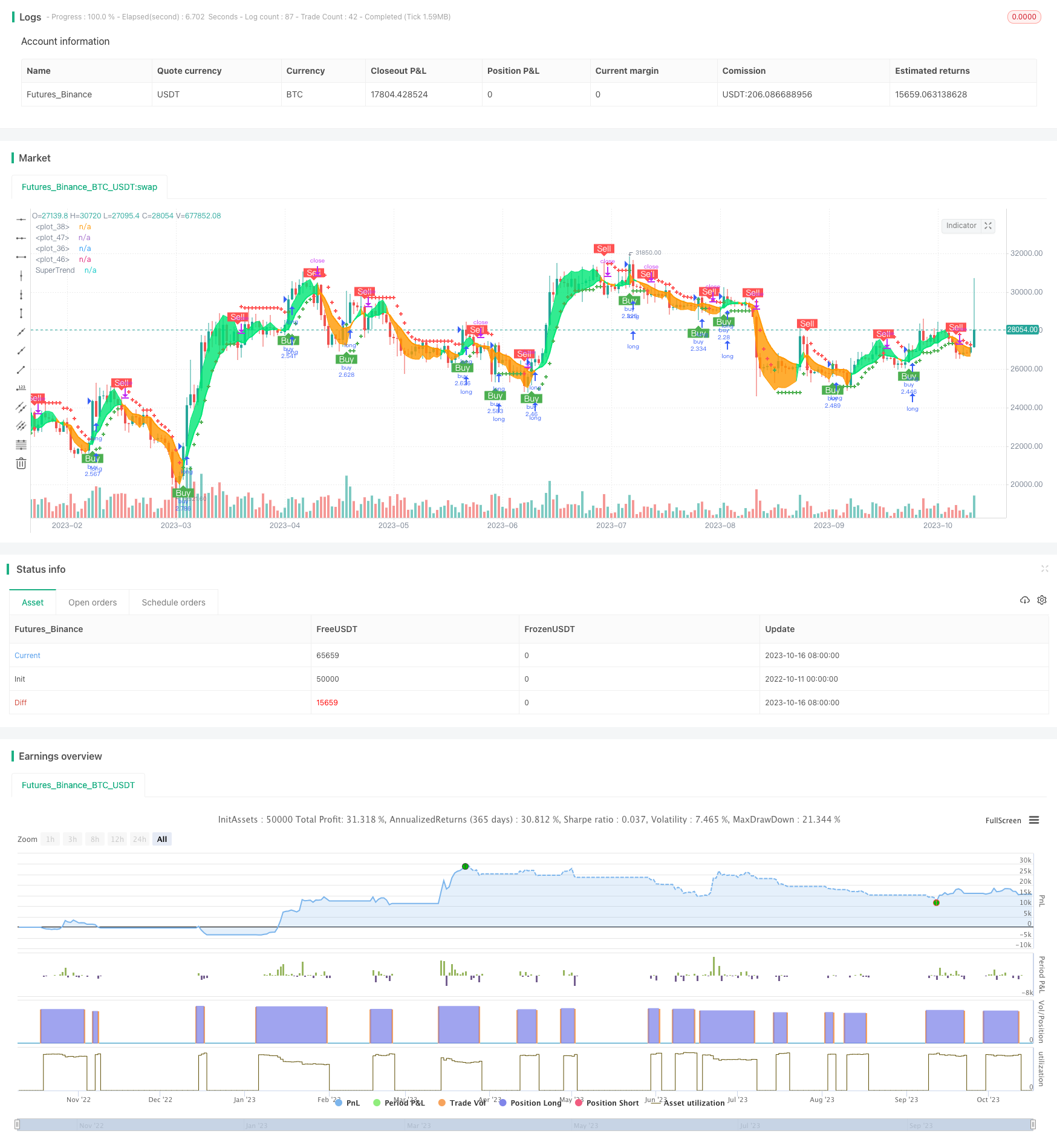
概述
超趋势V策略是一种基于移动平均线和标准差的短线交易策略。它利用Super Trend指标判断价格的趋势方向,结合移动平均线形成的支撑和阻力进行入场。同时,它利用标准差通道预测价格潜在的支撑和阻力区域,设定止损止盈的价格区间,实现趋势跟随和高效退出的短线交易策略。
策略原理
该策略首先计算Super Trend指标,Super Trend指标利用ATR和价格的关系判断趋势的方向。当价格高于上升趋势时为看涨,当价格低于下跌趋势时为看跌。
然后计算出价格的移动平均线EMA和开盘价的移动平均线EMA,当价格上穿移动平均线且高于开盘价均线时为买入信号,当价格下穿移动平均线且低于开盘价均线时为卖出信号。
接着利用标准差计算出价格通道的上下轨,并作平滑处理,价格突破标准差上轨时为止损信号,价格突破标准差下轨时为止盈信号。
最后,结合不同时间周期的移动平均线来判断趋势方向,与Super Trend指标结合,形成稳定的趋势判断。
策略优势
- 利用Super Trend指标判断价格趋势方向,避免趋势反转造成损失
- 移动平均线结合开盘价辅助判断入场时机,避免假突破
- 标准差通道预测价格潜在支撑和阻力区域,设置止损止盈价格
- 多时间周期结合判断趋势方向,提高稳定性
策略风险
- Super Trend指标存在滞后,可能漏掉趋势转换点
- 移动平均线产生交叉信号存在滞后,入场时机不准
- 标准差通道范围过于固定,不能实时反映市场波动
- 多个时间周期判断可能产生互相冲突
风险解决方法:
- 适当缩短Super Trend参数,提高敏感性
- 优化移动平均线周期,或加入其他指标判断入场
- 动态调整标准差通道参数,使范围能配合市场
- 确定清楚多周期判断逻辑,处理可能的冲突
策略优化方向
- 优化Super Trend参数,寻找最佳参数组合
- 尝试其他指标结合移动平均线判断入场时机
- 尝试动态调整标准差通道参数
- 测试不同的多周期组合,找到最匹配的周期
- 优化止损止盈策略,以提高策略获利空间
总结
超趋势V策略整合趋势、均线、标准差通道等指标优点,实现了稳定判断趋势方向,选择合适入场时机,并设置价格区域止损止盈的短线交易策略。通过参数优化、指标优化、止损止盈优化等方面进行改进,能够提高策略稳定性和盈利能力。其扎实的逻辑和严谨的思路值得学习和研究。
策略源码
/*backtest
start: 2022-10-11 00:00:00
end: 2023-10-17 00:00:00
period: 1d
basePeriod: 1h
exchanges: [{"eid":"Futures_Binance","currency":"BTC_USDT"}]
*/
// © theCrypster 2020
//@version=4
strategy(title = "Super trend V Strategy version", overlay = true, pyramiding=1,initial_capital = 1000, default_qty_type= strategy.percent_of_equity, default_qty_value = 100, calc_on_order_fills=false, slippage=0,commission_type=strategy.commission.percent,commission_value=0.075)
strat_dir_input = input(title="Strategy Direction", defval="long", options=["long", "short", "all"])
strat_dir_value = strat_dir_input == "long" ? strategy.direction.long : strat_dir_input == "short" ? strategy.direction.short : strategy.direction.all
strategy.risk.allow_entry_in(strat_dir_value)
hilow = ((high - low)*100)
openclose = ((close - open)*100)
vol = (volume / hilow)
spreadvol = (openclose * vol)
VPT = spreadvol + cum(spreadvol)
window_len = 28
v_len = 14
price_spread = stdev(high-low, window_len)
v = spreadvol + cum(spreadvol)
smooth = sma(v, v_len)
v_spread = stdev(v - smooth, window_len)
shadow = (v - smooth) / v_spread * price_spread
out = shadow > 0 ? high + shadow : low + shadow
//
src = out
src1=open
src2=low
src3=high
tf =input(720)
len = timeframe.isintraday and timeframe.multiplier >= 1 ?
tf / timeframe.multiplier * 7 :
timeframe.isintraday and timeframe.multiplier < 60 ?
60 / timeframe.multiplier * 24 * 7 : 7
c = ema(src, len)
plot(c,color=color.red)
o = ema(src1,len)
plot(o,color=color.blue)
//h = ema(src3,len)
//l=ema(src2,len)
//
col=c > o? color.lime : color.orange
vis = true
vl = c
ll = o
m1 = plot(vl, color=col, linewidth=1, transp=60)
m2 = plot(vis ? ll : na, color=col, linewidth=2, transp=80)
fill(m1, m2, color=col, transp=70)
//
vpt=ema(out,len)
// INPUTS //
st_mult = input(1, title = 'SuperTrend Multiplier', minval = 0, maxval = 100, step = 0.01)
st_period = input(10, title = 'SuperTrend Period', minval = 1)
// CALCULATIONS //
up_lev = vpt - (st_mult * atr(st_period))
dn_lev = vpt + (st_mult * atr(st_period))
up_trend = 0.0
up_trend := close[1] > up_trend[1] ? max(up_lev, up_trend[1]) : up_lev
down_trend = 0.0
down_trend := close[1] < down_trend[1] ? min(dn_lev, down_trend[1]) : dn_lev
// Calculate trend var
trend = 0
trend := close > down_trend[1] ? 1: close < up_trend[1] ? -1 : nz(trend[1], 1)
// Calculate SuperTrend Line
st_line = trend ==1 ? up_trend : down_trend
// Plotting
plot(st_line[1], color = trend == 1 ? color.green : color.red , style = plot.style_cross, linewidth = 2, title = "SuperTrend")
buy=crossover( close, st_line) and close>o
sell=crossunder(close, st_line) and close<o
//plotshape(crossover( close, st_line), location = location.belowbar, color = color.green,size=size.tiny)
//plotshape(crossunder(close, st_line), location = location.abovebar, color = color.red,size=size.tiny)
plotshape(buy, title="buy", text="Buy", color=color.green, style=shape.labelup, location=location.belowbar, size=size.small, textcolor=color.white, transp=0) //plot for buy icon
plotshape(sell, title="sell", text="Sell", color=color.red, style=shape.labeldown, location=location.abovebar, size=size.small, textcolor=color.white, transp=0) //plot for sell icon
//
multiplier = input(title="TP VWAP Deviation", type=input.float, defval=2, minval=1)
src5 = vwap
len5 = input(title="TP length", defval=150, minval=1)
offset = 0
calcSlope(src5, len5) =>
sumX = 0.0
sumY = 0.0
sumXSqr = 0.0
sumXY = 0.0
for i = 1 to len5
val = src5[len5-i]
per = i + 1.0
sumX := sumX + per
sumY := sumY + val
sumXSqr := sumXSqr + per * per
sumXY := sumXY + val * per
slope = (len5 * sumXY - sumX * sumY) / (len5 * sumXSqr - sumX * sumX)
average = sumY / len5
intercept = average - slope * sumX / len5 + slope
[slope, average, intercept]
var float tmp = na
[s, a, i] = calcSlope(src5, len5)
vwap1=(i + s * (len5 - offset))
sdev = stdev(vwap, len5)
dev = multiplier * sdev
top=vwap1+dev
bott=vwap1-dev
//
z1 = vwap1 + dev
x1 = vwap1 - dev
low1 = crossover(close, x1)
high1 = crossunder(close, z1)
plotshape(low1, title="low", text="TP", color=color.red, style=shape.labelup, location=location.belowbar, size=size.small, textcolor=color.white, transp=0) //plot for buy icon
plotshape(high1, title="high", text="TP", color=color.green, style=shape.labeldown, location=location.abovebar, size=size.small, textcolor=color.white, transp=0) //plot for sell icon
//
// Testing Start dates
testStartYear = input(2016, "Backtest Start Year")
testStartMonth = input(1, "Backtest Start Month")
testStartDay = input(1, "Backtest Start Day")
testPeriodStart = timestamp(testStartYear,testStartMonth,testStartDay,0,0)
//Stop date if you want to use a specific range of dates
testStopYear = input(2030, "Backtest Stop Year")
testStopMonth = input(12, "Backtest Stop Month")
testStopDay = input(30, "Backtest Stop Day")
testPeriodStop = timestamp(testStopYear,testStopMonth,testStopDay,0,0)
testPeriod() =>
time >= testPeriodStart and time <= testPeriodStop ? true : false
l = buy
s1 = sell
if l and testPeriod()
strategy.entry("buy", strategy.long)
if s1 and testPeriod()
strategy.entry("sell", strategy.short)